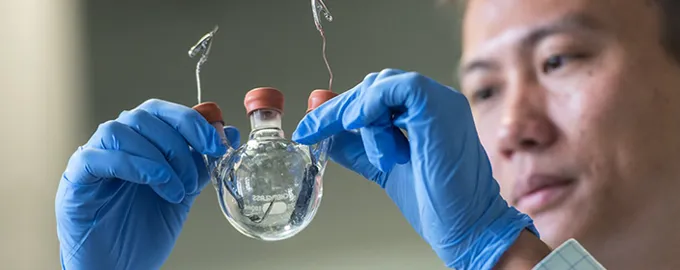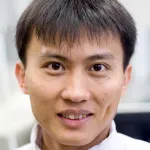
Photo by Matt Beardsley/SLAC of Dr. Yi Cui.
Stanford Engineering - April 28th, 2016 - by Ian Chipman
What do a battery, a facemask and a solar cell have in common?
They are just a few of the innovations to emerge from the highly productive lab of Stanford materials scientist Yi Cui. Working with a talented group of graduate students, Cui explores the intersection of advanced materials design and nanoscale phenomena, pushing boundaries in both theoretical and real-world applications.
Since 2010, his group has published more than 30 papers per year, addressing some of the world’s most pressing environmental and technological challenges, from game-changing renewable-energy concepts to seminal research that is revolutionizing the battery.
Repurposed Materials for the Common Good
Even as Cui pushes the technological edge, his research group is also exploring how to repurpose common materials to create next-generation air and water purification membranes. By coating a simple cotton cloth in carbon and silver nanostructures and then electrifying it, they created an ultra-fast water filter that zaps bacteria dead rather than trapping them with small pores. This low-cost alternative is 80,000 times faster than conventional water filters, Cui said, and “it can easily be used in remote areas where people don’t have access to chemical treatments such as chlorine.”
A related invention was born after Cui choked through a number of business trips to China. He looked for a cheap yet effective material that could be fashioned into air filters to make breathing easier in smog-filled cities. His team converted liquid polyacrylonitrile — the stuff commonly used to make surgical gloves — into fibers with a diameter a tiny fraction of a human hair. A filter made of this material lets air and light pass through efficiently while collecting 10 times its weight in particulate pollution. “We think we could use this material for personal masks, window shades and even filters for automobile and industrial waste,” Cui said. “It works really well, and it might be a game-changer.”
New Energy Frontiers
Cui has also devoted considerable brainpower to the quest of making renewable energy more competitive. In 2014 his team developed ultrathin solar cells that would not only push down the cost-efficiency of photovoltaic materials, but also revolutionize the fundamental structure of rooftop installation. “These thin silicon cells can be embedded into flexible plastic, making installation like rolling out a carpet,” Cui said.
At the other end of the renewable energy spectrum, Cui’s team is looking to reshape the puzzle of integrating solar and wind power into the grid. To make grid-scale battery storage viable, Cui believes we would have to cut battery costs by more than half and triple their life cycle, or the number of times batteries can charge and discharge before they must be replaced. A semi-liquid battery design he developed in collaboration with the SLAC National Accelerator Laboratory might chart a course toward those ambitious goals.
The Promise and Peril of Silicon Anodes
Cui’s inventory of innovations and discoveries is ample proof that he is no single-track researcher. But if one thing has defined his career thus far, it might the pursuit of a single element’s potential to push batteries to do bigger and better things. Fittingly, for a man who works in the heart of Silicon Valley, that element is silicon. During a recent lecture at SLAC, Cui spoke about a decade’s worth of research to adapt silicon, already the bedrock of computer chips, to the task of making smaller yet more powerful batteries.
Cui recalled that when he first saw a brick-sized cellphone as a child, he wondered what it was for. “Is it for self-defense or something that you would carry something that big?” Part of the reason for the bulk of early mobile phones was the size of their power source. Decades later, through the evolution of svelte yet ever-more-powerful lithium-ion batteries, everything from shirt-pocket cell phones to electric vehicles have become common and increasingly affordable. But still Cui is guided by a simple question: How far can battery technology go?
Despite tremendous advances, he believes that the answer is quite a bit further. In most lithium-ion batteries, the anode, or the negative electrode, is typically constructed from graphite or other carbon-based materials. These are cheap, abundant and exhibit good energy density. However, the theoretical capacity for batteries with silicon anodes is more than 10 times greater than graphite. Such silicon-enabled batteries might mean phones that run for days and electric cars that could range for hundreds of additional miles.
So what’s stopping industry from making the switch to silicon anodes and unleashing a new paradigm of high-energy-density batteries? For all its benefits, silicon’s fatal flaw is its propensity to swell and crack. In fact, when storing lithium ions, a silicon anode can expand up to four times its original size. Cui says his upbringing in Guangxi province in southern China has given him some appreciation of what happens when materials swell.
“When I was a little kid,” Cui said, “my hometown was very hot in summer. In the winter it got cold. It went through this cycle, hot and cold, and the furniture actually cracked.”
But the problem he recalls with furniture is mild compared to the stresses silicon anodes face. “That was only probably 10 percent,” he said, adding that with silicon anodes, “we are talking about 400 percent right here. How do you avoid breaking?” When a silicon anode stores lithium ions, in a sense “it commits suicide,” he said — a dangerous propensity for a battery.
To solve this challenge of silicon particles swelling and cracking the battery, Cui’s lab has spent 10 years developing 11 generations of silicon-anode designs that exhibit increasing stability. These designs employ different nanoscale structures, ranging from hollow nanotubes and shells to pomegranate-like clusters and graphene cages. In every case the idea is the same: to surround the silicon particles and allow them to swell and contract, storing and releasing energy, without bursting free to break the battery.
With each successive iteration, Cui and his team have increased the stability of silicon anodes and inched closer to realizing silicon’s theoretical potential. If a decade of incremental progress on a single problem sounds daunting, Cui remains as energized as ever.
“Silicon is so promising,” he said. “Imagine, if you can come up with one idea to make it work — all these 10 years of learning is worth it.”
Cui isn’t merely interested in making silicon work in the lab — he also wants to help bring it into the commercial mainstream. In 2008 he co-founded Amprius, a battery startup that uses his nanoscale research as its core intellectual property. It has raised over $100 million to bring silicon-anode technology into real-world battery applications.
Using Materials Science to Address Water Shortages
Cui is also thinking about how batteries might help solve the vexing energy challenge associated with water desalination. During a recent seminar on the nexus of energy and water, he spoke about how water shortage problems are largely energy and cost problems. While there is a nearly limitless amount of seawater, the energy required to remove the salt is prohibitive. Cui outlined how the dominant strategy of reverse osmosis — which uses pressure to push salt water through a membrane to get freshwater on the other side — consumes 5 to 8 times more energy than what thermodynamic theory suggests is possible. To minimize this kinetic loss, Cui’s group invented a device they call a water desalination battery that uses seawater as the electrolyte. As the battery charges and discharges, chemically synthesized nanorods pull out sodium and chlorine ions, leaving freshwater behind. Experimental data suggests that this highly efficient desalination battery would consume only a fraction of the energy needed for reverse osmosis.
Spinning a similar idea in the reverse direction, Cui’s team also developed a nanotechnology-aided battery that generates electricity by exploiting the salinity imbalance between freshwater and seawater. This could unleash a large source of renewable energy, as a power plant could use such a battery anywhere a river flows into the sea. And if it were possible to harness the world’s supply of such rivers, Cui said, we could theoretically generate 2 terawatts of electricity — roughly 13% of the world’s energy consumption.
Ever conscious of technology’s impact on the environment, Cui knows that river mouths and estuaries are often ecologically sensitive areas. “You would want to pick a site some distance away, miles away, from any critical habitat,” Cui said. “We don’t need to disturb the whole system, we just need to route some of the river water through our system before it reaches the ocean. We are just borrowing and returning it.”
These ideas are helping to launch a sea change in the relationship between energy and water. “Nanotechnology is bringing very exciting opportunities — new ideas, new materials, new devices, new mechanisms for treating water,” Cui said. “This has become some of the key research guiding my group.”

